Ever step out of a hot shower and feel that chilly draft sneak in? I’ve been there, shivering and grabbing a towel like it’s a winter coat. Here’s the thing: a ceiling to floor shower curtain can make your bathroom feel warmer, quieter, and a whole lot more stylish—especially in winter. If you’re wondering how to choose the right one (and whether you need special hardware), don’t sweat it—I’ve got you.
You don’t need a renovation or a fancy contractor. With a little measuring and a smart fabric choice, you can create that cozy, spa-like vibe in a weekend. Let’s keep it simple and walk through options I’ve tried, loved, or recommended to friends.
Why ceiling to floor shower curtains feel cozier in winter
I like to think of a floor-length curtain as a gentle hug for your shower. It blocks drafts, traps steam, and makes a compact bathroom feel taller.
Key benefits (and why they matter when it’s cold):
- Better warmth: Extra length minimizes the gap where cold air sneaks in.
- Spa look: Floor-length reads boutique hotel—instant upgrade.
- Visual height: Hanging from the ceiling draws the eye up, which makes even small bathrooms feel calm and airy.
- Splash control: Less water on the floor means fewer cold puddles and less cleanup.
- Sound softening: Heavier weaves (like waffle or linen blend) muffle echoes and make your space feel calm.
Pro tip: If you love a toasty shower, choose a thicker fabric or an insulated liner. It’s amazing what a little extra weight can do.
Get the length right (it’s easier than it sounds)
A great curtain hangs just right. You don’t want a sloppy puddle or a chilly gap. Aim for a ¼–½ inch off the floor for most bathrooms. If you like a luxe “pool,” add ½–1 inch to the length and keep a bath mat handy.
Here’s the quick measuring game plan:
- Ceiling height: Most homes are about 96″ (8 ft), but measure yours.
- Rod or track drop: If you’re using a ceiling-mounted track, that’s typically a 1–2″ drop. Hooks add another 1–2″.
- Curb or tub ledge height: Usually 1–6″ depending on a shower curb or tub.
- Desired gap: ¼–½” above the floor keeps things tidy and dry.
Common sizes:
- 84″ (extra-long): Good for taller tub installations.
- 90″–96″ (ceiling to floor): Great for 8–9 ft ceilings.
- 108″+ (oversize/custom): For lofty spaces or when you want a slight pool.
Installation note: If your floor isn’t perfectly level (very common), set your curtain based on the highest point and let the rest skim. It looks neater and avoids damp edges.
Try this handy length calculator (so you don’t have to guess)
Below is a simple tool I put together to help you calculate the ideal curtain length based on your ceiling height and hardware. It also suggests the closest standard size so you can shop with confidence.
What you’ll need: your ceiling height (inches), the drop of your rod/track, your hook height, the height of your shower curb or tub ledge (if applicable), and your preferred floor gap.
Shower Curtain Length Calculator
How to use it: Pop in your measurements, hit Calculate, and you’ll get your best length and the nearest off-the-shelf option. Keep it simple—if you’re between sizes, I usually go longer and adjust the rod slightly.
The 10 best ceiling to floor shower curtain ideas for winter
You don’t need the exact same bathroom as a magazine spread. Pick a style that fits your space, your budget, and the way you live. Here are ten tried-and-true types I recommend all the time.
1) Waffle-weave cotton (hotel feel without the fuss)
I love waffle-weave because it looks high-end and cozy right away. The texture traps a bit more warmth and adds dimension.
- Look for: 90″–96″ length, 70–72″ width, 100% cotton or cotton blend.
- Color tip: Cream, white, or warm gray soften cool tile and make winter light feel kinder.
- Care: Machine-wash on warm, low heat dry.
- Pro tip: Pair with a weighted PEVA liner to keep drafts out.
Why it works: The small honeycomb pattern reads spa, which is exactly the vibe you want when the temperature drops.
2) Thermal-lined (practically a blanket for your shower)
What I’ve found is that a thermal or insulated liner makes a real difference on cold mornings. It’s a simple way to trap steam where you want it.
- Ideal for: Drafty rentals, corner showers, and bathrooms with big windows.
- Specs: Look for a flannel backing or thermal interlining; length 90″+.
- Bonus: Often noise-softening, which makes your bathroom feel serene.
- Pro tip: Keep the liner 1–2″ shorter than the fabric curtain for a clean look.
3) Linen blend (soft, airy, and grown-up)
I like linen blends (linen + cotton or linen + polyester) because they drape beautifully but don’t wrinkle as much as pure linen.
- Color ideas: Oatmeal, natural flax, or soft taupe feel warm without darkening the space.
- Weight: Medium; add a weighted hem for a polished skim above the floor.
- Care: Gentle cycle, hang dry to protect the weave.
- Pro tip: Use matte black or antique brass hooks for a subtle wintery contrast.
4) Extra-wide for clawfoot tubs (no more chilly gaps)
If you’ve got a freestanding or clawfoot tub, go wider—think 180″–200″ circumference. A curtain that wraps fully around is the coziest option.
- Hardware: A ceiling-mounted circular rod or a wraparound track is your best friend.
- Pattern: Classic white or soft stripe keeps it timeless.
- Pro tip: Use double liners inside to manage splash while the outer fabric skims the floor.
5) Double-panel with weighted hems (tailored and toasty)
Two panels that meet in the middle feel like drapes—and they seal better than a single panel.
- Measurements: Two panels at 36–40″ width each, length 90″+.
- Detail to check: Weighted corners and a reinforced header for smooth sliding.
- Pro tip: Add magnetic seam clips where panels meet to block sneaky drafts.
6) Herringbone or subtle plaid (texture that reads warm)
When you want pattern without loud color, try herringbone, micro-plaid, or basketweave. These look classic and cozy up tile instantly.
- Color combo: Warm gray on ivory or charcoal on beige.
- What I love: They hide water spots between washes.
- Pro tip: Pair with a round or curved rod to add elbow room and better drip control.
7) Performance polyester with luxe drape (low-maintenance, high style)
If you want an easy-care workhorse, a modern performance polyester is surprisingly soft and often mildew-resistant.
- Look for: 90″–96″ length, weighted hem, and machine-washable labels.
- Finish: Matte beats shiny in winter—more cozy, less slippery look.
- Pro tip: Choose a thermal liner for warmth without sacrificing easy care.
8) Rich color block (instant warmth with zero clutter)
A curtain with a deep bottom band (think cocoa, forest green, or navy) grounds the room and feels winter-ready.
- Why it works: The color at floor level anchors the space and hides any minor puddling.
- Pair with: Warm brass hardware and a cream bath mat.
- Pro tip: Keep walls light so the color band feels intentional, not heavy.
9) Botanical or woodsy print (cozy without being cutesy)
Florals don’t have to feel springy. Botanicals in muted tones—olive, rust, and charcoal—read like a forest walk.
- Keep it calm: Choose soft, desaturated colors on an off-white ground.
- Match with: Woven baskets, cedar bath mat, and matte black fixtures.
- Pro tip: If your tile is busy, scale down the print to avoid visual noise.
10) Minimalist micro-stripe (crisp, bright, and winter-friendly)
A thin stripe in warm gray or sand keeps things clean and brightens dim winter light.
- Specs: Stripe repeat under ½”; length 90″+.
- Why I like it: It plays well with almost any tile or paint color.
- Pro tip: Cream or taupe walls make micro-stripes look intentional and soft.
Choosing the right liner (the unsung hero)
You can have the prettiest fabric in the world, but the liner does the heavy lifting—especially for winter warmth and easy cleanup.
What to consider:
- Material: PEVA or EVA (PVC-free) resists mildew and wipes clean. Fabric liners feel softer but need more frequent washing.
- Length: 1–2″ shorter than the fabric curtain if outside the tub; longer if you’re using it solo inside the tub.
- Weights: Magnets or a weighted hem help block drafts and prevent “billowing.”
- Grommet vs. buttonholes: Grommets glide easier on tracks; buttonholes look classic on hooks.
Pro tip: If warmth is your top goal, stack a thermal liner behind your regular liner. It sounds extra, but it’s a game changer in a chilly bathroom.
Hardware that makes it all work (without a contractor)
You don’t need to overhaul your shower to hang a floor-length curtain. Keep it simple with the right rod or track.
Ceiling-mounted tracks (cleaner lines, best draft control)
- Why I love them: They seal the top edge, look custom, and glide smoothly.
- Track drop: Usually 1–2″. Add hook height to your length calculation.
- Mounting tip: Use drywall anchors rated 25–50 lbs and space them per the manufacturer’s instructions.
High-mount rods (when a track isn’t practical)
- Curved rods add elbow room and help water drip inward.
- Straight rods are minimal and easier to install.
- Tension rods work for rentals, but check the weight of your curtain and liner.
Hooks, rings, and glides (small parts, big difference)
- Roller rings glide smoothly on tracks.
- Closed rings keep curtains from popping off.
- Hookless headers are tidy but check the ring height for your measurements.
Pro tip: If steam escapes at the top, raise the rod or switch to a ceiling track. The difference in warmth can be surprising.
Colors and patterns that feel warm (even with cool tile)
If you’ve got white tile or a cooler gray, winter light can make it feel a little stark. You can warm it up with color and texture without repainting.
My favorite winter-friendly combos:
- Cream or oat + matte black hardware: Soft but graphic.
- Taupe micro-stripe + warm brass: Polished without feeling fancy.
- Olive botanical + cedar bath mat: Nature-inspired and calming.
- Navy color block + ivory towels: Classic, clean, and cozy.
Quick styling wins:
- Add a plush bath mat with a dense pile (20″ × 34″ is a nice everyday size).
- Swap in warm LED bulbs (2700–3000K) for gentler light.
- Layer soft towels—2 bath sheets and 2 hand towels per person keeps laundry reasonable.
Caring for your curtain so it lasts (and stays fresh)
A floor-length curtain sees a bit more splash, so simple upkeep matters—but it doesn’t have to be a chore.
Easy routine:
- Weekly: Let the curtain fully dry by spreading it open after showers.
- Biweekly: Wipe the liner with a mix of warm water and a few drops of dish soap.
- Monthly: Machine-wash fabric curtains on gentle; add a cup of white vinegar to the rinse to reduce soap residue.
- Seasonally: Check hems and hooks, and trim loose threads so they don’t wick water.
Pro tip: If the bottom edge gets damp often, drop your liner 1–2″ and let the fabric curtain skim the floor—not touch it.
Budget-savvy moves (and easy DIY ideas)
You don’t have to spend a lot to get a cozy result. Small tweaks make a big difference.
- Use a plain 96″ curtain panel (for windows) as your shower curtain—just add rust-proof grommets or ring clips.
- DIY a weighted hem with lead-free drapery weights or discreet magnets.
- Upgrade hooks—swapping to roller rings instantly improves glide and feel.
- Hack the rod height by going as high as you can; it’s basically a free “custom” look.
Quick wins under an hour:
- Swap to a thermal liner.
- Add a bath mat with memory foam.
- Clean and relight with warm bulbs.
- Mount a simple ceiling hook for a hanging plant (pothos loves bathroom humidity).
Troubleshooting common “uh-ohs”
Even friends who are handy run into these. Here’s how to fix them fast.
- Curtain puddles too much: Raise the rod ½–1″. If you can’t, hem with fusible tape (10 minutes with an iron).
- Billowing curtain: Add magnetic weights at the bottom corners or switch to a weighted liner.
- Musty smell: Wash the liner, run the fan for 15–20 minutes after showers, and keep the curtain open to dry.
- Cold draft at the seam: Use magnetic seam clips or choose a double-panel setup with overlap.
- Water escaping at the ends: Try a curved rod or extend the track 3–4″ past the opening on each side.
Quick shopping and setup checklist (so you don’t forget the little things)
- Measure ceiling-to-floor height and decide on gap or pool.
- Pick your style: waffle, linen blend, thermal, wide, patterned, or color block.
- Choose a liner: PEVA/EVA, fabric, or thermal—weighted if possible.
- Select hardware: ceiling track or high rod, roller rings, anchors.
- Plan care: machine-wash schedule, vinegar rinse, liner wipe-downs.
- Add finishing touches: warm bulbs, plush mat, towels, and maybe a wintery eucalyptus stem.
Final thoughts
Big takeaway: A ceiling to floor shower curtain is a simple, affordable winter upgrade that adds warmth, blocks drafts, and pulls your bathroom together. You don’t need to renovate or overthink it—keep it simple with a cozy fabric, a good liner, and the right length.
If this feels like a lot, start with one or two ideas: swap in a thermal liner and raise your rod. Then, when you’re ready, pick a curtain style that makes you smile every morning. It’s amazing what a few simple touches can do!

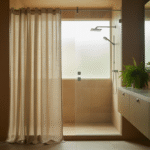
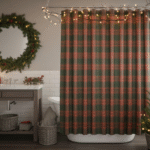
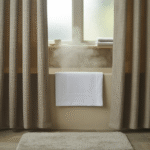
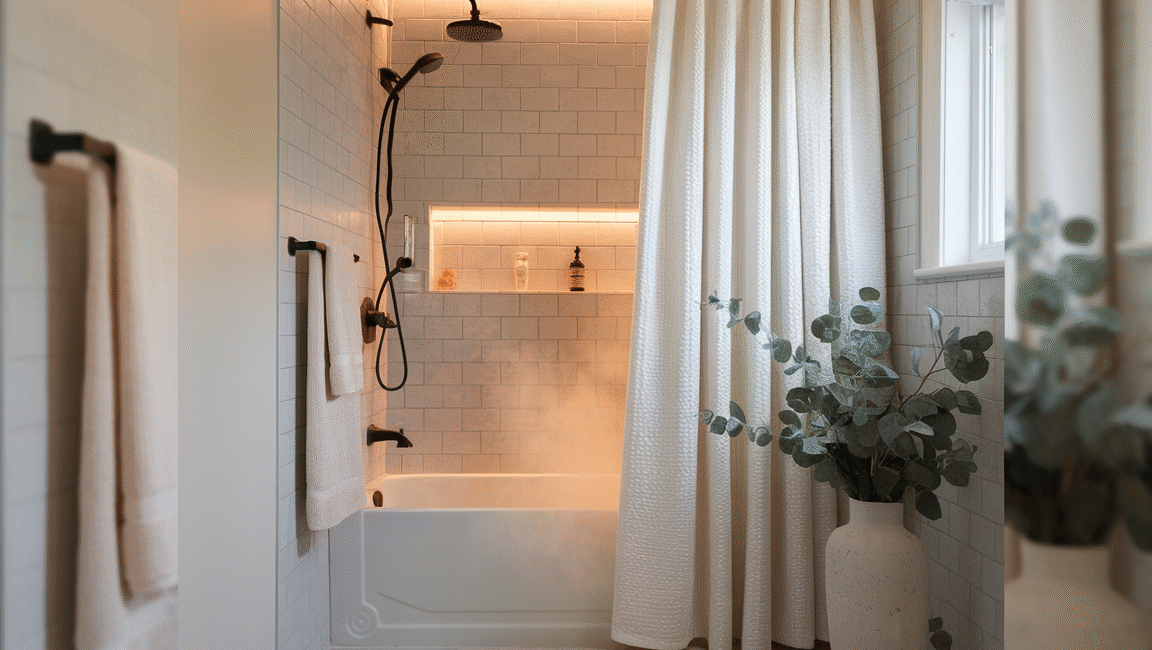
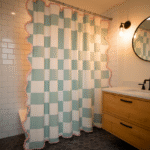
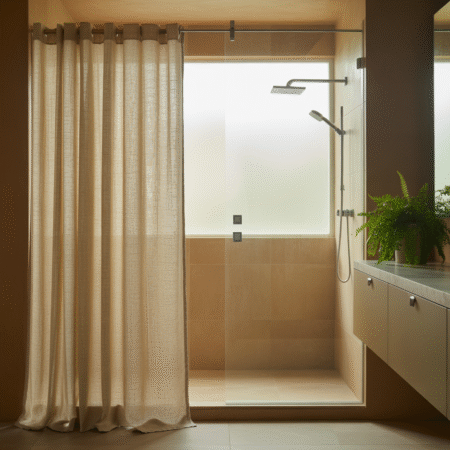
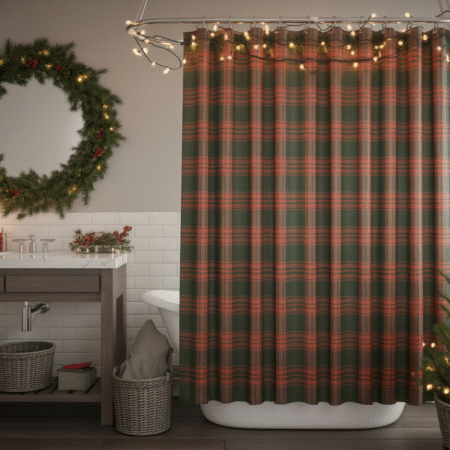
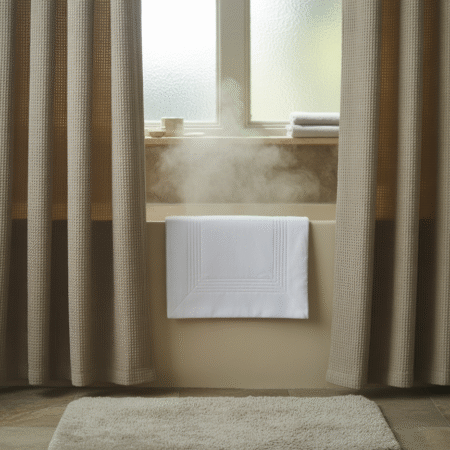
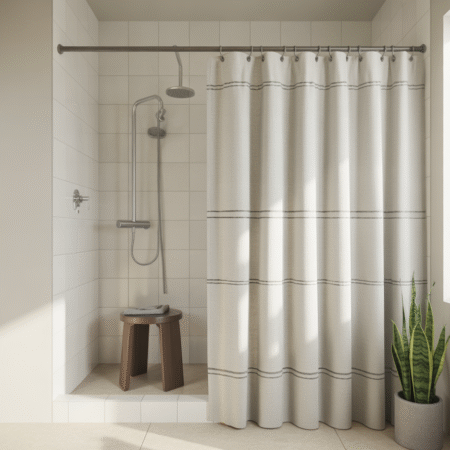
Hello